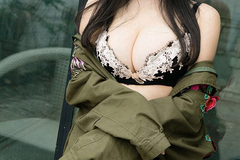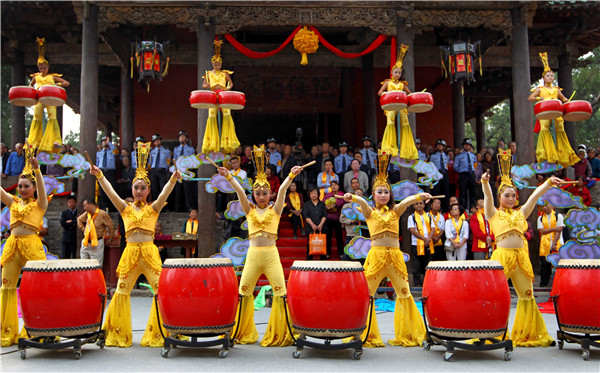
The folk art performance has a long history in Yuncheng. According to the cultural relics of Han, Jin, Tang, song, Jin and Yuan Dynasties unearthed in Wenxi, Xinjiang, Jishan, Ruicheng, Yuncheng and other counties (cities), Tongxiang (now Wenxi County) and Quwo in the Han Dynasty were popular with folk art performance. From the Tang and Song Dynasties to the Jin and Yuan Dynasties, the folk art performance was very popular in all counties in the region. The variety of folk art performance has been expanded from juggling to sound (gongs and drums, flower drums), dance (lion dance, dragon dance), sports (martial arts, stilts), viewing (iceberg, pavilion lifting), etc., with richer contents and more spectacular scenes. In the old days, folk art performance was held in traditional festivals (Lantern Festival, Dragon Boat Festival, Double Ninth Festival), sacrificial rites, spring and autumn praying and celebration (birthday and wedding). After the founding of the People's Republic of China, all kinds of folk art performance have been developed on the basis of the original, and become the main form of mass cultural activities on every traditional festival. People also use this traditional form of folk entertainment to celebrate National Day, Army Day and Labor Day, etc., or to boost various commencement ceremony, completion ribbon-cutting ceremony, and business activities. The popular types of folk art performance with local characteristics are as follows:
Gongs and Drums
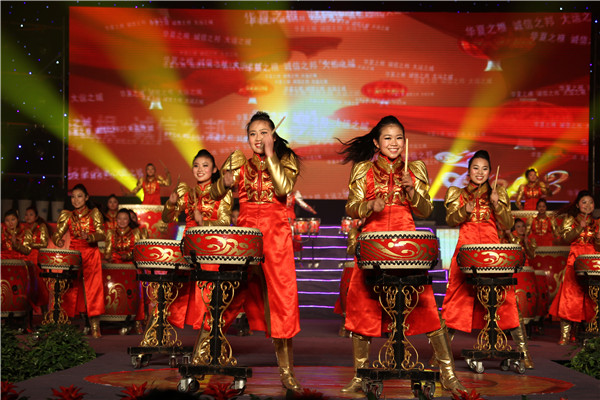
It is popular in the towns and villages of Yuncheng, and is mainly used for celebration, sacrificial rites, funeral, etc. The instrument is mainly equipped with drums, gongs, Cha and cymbals, supplemented by small chas, Yunluo, Baogu(a kind of hand-held small drum), etc. The number of percussion sets and performance style vary from place to place. Jiangzhou (i.e. Xinjiang County) gongs and drums are mainly composed of drum music. The representative track King Qin Ordered Soldiers is well-known in China. It has also been invited to perform in Hong Kong, Southeast Asia and some countries in northern Europe. Gongs and drums in Dongguo Township and Beixiang town of Yuncheng City have great momentum and fast rhythm. The representative track Guang Gong Defeats Chiyou (adapted from a myth) is well-known both inside and outside the province. Hejin City takes Fenbei gongs and drums as its best. Some performing team consists of dozens of people, some even hundreds of people. The performers are dressed in ancient Samurai costumes. The conductor holds a pole about two meters long. The head of the pole is decorated with pompon and colored silk. The sound of gongs and drums sounds like mountain torrents coming out of the valley and thunder from the sky. The representative repertoires include Luan Gua Feng, Feng Jiao Xue and Shizi Gun Xiuqiu, etc. In addition, Dingfan and Niandi Gongs and Grums of Wanrong county, Songdian of Wenxi County and Zhangdian of Pinglu are also famous.
Stilts

Commonly known as "trampling on crutches", it is popular in towns and villages in the whole area. Performers step on wooden instruments with foot treading devices (commonly known as crutches), make up for various characters in myths, legends, traditional opera or modern operas, and dance with the accompaniment of gongs and drums. The height of the crutches varies from 1-1.5 meters for the low and 2-3 meters for the high. There are single crutch, double crutches and crutches for three or four people. Performing stunts include going up to a high table, doing the splits, etc. The performance of "driving donkeys" in Xiguan, Linjin Town of Lincai county is unique: the wife rides the donkey with a basket, the husband whips the donkeys. They fall down accidentally, and then the wife throws the colored training to the husband. They each stretch one leg to the other and the wife pulls him. After the husband immediately rises, they two look at each other and smile, and then go on. The stilts performances in Yuncheng, Yongji, Wanrong, Yuanqu and other counties (cities) also have their own characteristics and are popular with the people.
Huagu
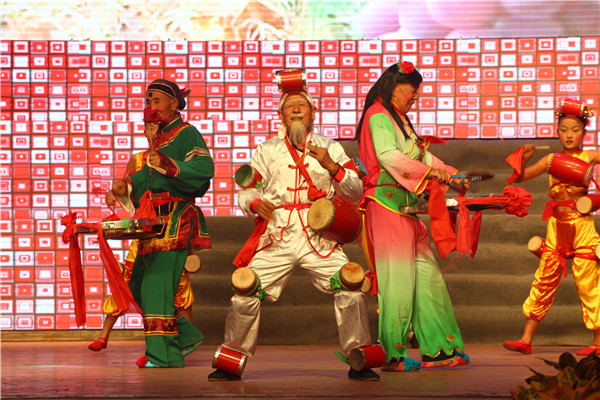
It is popular in urban and rural areas of the region, and has a high reputation in Wanrong and Wenxi counties. It is said that Huagu originated in Tang Dynasty and flourished in Song Dynasty. During the performance, in addition to one person playing drums, there is another singer, known as "umbrella head", accompanying by more than 10 girls hitting Yunluo(Chinese gong chimes). There are three positions for drummers: low drum, i.e. waist tied drum; high drum, i.e. chest drum; multi drum, i.e. tied drum on head, chest, shoulder and leg, with 7-8 drums. When beating drums, we should pay attention to the graceful dancing and loud drumming. There are many drumming styles, such as "a little oil", "wind stirs snow", "dry fried beans", "dog hisses and bites", "tight three hammers", "slow three hammers", etc. When walking round the field, there are many ways, such as "cabbage rolling", "dragon swinging tail", "stepping on four corners", "cross flowers ", “cicada molting ", and "backward grinding". In the technique of drum beating, there are waist pulling, leg pulling, knee winding and various kinds of difficult movements, such as "lion rolling Hydrangea", "King Qin back sword", "Phoenix double wings" and so on. The style of flower drum varies with different regions. Among the flower drums in Wanrong County, there are southwest Township, Southeast Township and North Township. The rhythm of Southwest Township is tight and the movement differs greatly; the rhythm of Southeast Township is slow and the movement is humorous; the movement of North Township is steady and generous. The deceased famous flower drum artists include Yin Tingyan of Wenxi County, Wang Tianfu and Chang Chunsheng of Wanrong County, etc. Wang Tianfu's student Tian Jinchuan got his master's skills. He has performed in the provincial capital and Beijing for many times, and was received by Zhou Enlai, Deng Xiaoping and other party and state leaders. His performance has also been made into films and TV programs broadcasted all over the country.
Dragon Lantern
The dragon lantern in this area originated in the Han Dynasty, also known as "playing Dragon Lantern". The dragon lantern is pasted with bamboo and colored silk. The Dragon scales, dragon heads and dragon horns are drawn on it. It looks lifelike and powerful. The dragon who can spray fire in the mouth is called "fire dragon" and those who can spray water are called "water dragon". The head of a dragon lantern is divided into several sections. Each section is equipped with a long handle, which is operated by the dragon lantern player. A candle is lit inside each section, and the whole dragon is more than 20 meters long. It is usually performed at the night of the Lantern Festival, coordinated by 20-30 operators, making curling, rolling, jumping and other movements, accompanied by gongs and drums, or walking along the street, or performing in circles in the square, which is grand and spectacular. In 1989, according to the myth and scientific principle, the folk art lovers in Jiangxian County transformed the traditional dragon lantern making process. They use super light material filled with hydrogen, so that the dragon lantern can rise in the wind, gently and gracefully, soar to the sky, named "Jade Dragon soars into the sky". In 1989, the first experiment was successful and performed in Yuncheng during the Lantern Festival In 1990. It has participated in the opening ceremony of the 11th Beijing Asian Games, in the celebration of Hong Kong's return in 1997, and visited Japan upon invitation, all of which have won high praise.
Water Story
It is unique to Fudi Village in Wenxi County and originated from the early Qing Dynasty. They cut various characters, birds and animals, fish and insects, pavilions and pavilions with hard paper and paint them with colored pens. The characters will be fixed in special positions in a large device to form one or several stories. During the performance, they will be driven by water power. When the power is on, the figures and animals move together, which is very vivid and interesting.
Carrying Height

It is popular in villages and towns along the Yellow River in Ruicheng County and Yongji City, also known as "carrying frame". The performer installs a frame and an iron bar which is higher than his head on his body. A pedal and a round iron ring are installed on the top of the iron bar. During the performance, a kid will be dressed as drama character and stuck in the iron ring, making it a fixed shape. Generally, there is a group of drama characters. In the accompaniment of gongs and drums, the backers run forward and backward, intersperse and perform. In some plays, there are two kids stuck in the iron ring.
Carrying Ice

It is unique to Changwang village in Shouyang Township of Yongji city. During the performance, one person carried purlins more than ten meters long in front of the guide, known as "flagpole". There is no limit to the number of performers. The performers are not afraid of the severe cold, with bare foot and bare back, only wearing shorts. Carrying huge ice on their backs, they will dance with the accompaniment of gongs and drums. This kind of Folk Art Performance originated in the years of Xianfeng and Tongzhi (1851-1874). It is said that when Xiang Fulu of Changwang village was appointed as the commander of the Qing army, he fought with the peasant uprising army of the Taiping Heavenly Kingdom at the Maojin ferry. The Qing army set up two fire walls on the North Bank of the Yellow River. The Taiping army, fearing the severe cold, crossed the river with ice on its back to break through the defense line of the Qing army. Xiang Fulu admired the bravery and tenacity of the Taiping army, and advocated carrying ice after retiring to his hometown, which has been spreading to this day.
Ice Mountain
Originated in the late Sui and early Tang Dynasty, the ice mountain is popular in Chengbei Village of Hejin City. It was created by a craftsman in Chengbei Village. Before the Spring Festival, the ice mountain must be finished which is very time-consuming. A large wooden frame would be made and bounded with linen. After being inverted, the strong lye from the lotus pond in the south of the city would be splashed on it. A big windmill is placed around the mountain frame and more than 20 people take turns to fan it day and night, so that the temperature drops to forty or fifty degrees below zero. The poured lye will be frozen layer by layer immediately. After shaping, it will be inverted for decoration with pine branches and cypress leaves, steps and pavilions. The final products look like a mountain made of jade. They are carried by carts (now mostly by trucks) for people to watch.Ice Mountain
Originated in the late Sui and early Tang Dynasty, the ice mountain is popular in Chengbei Village of Hejin City. It was created by a craftsman in Chengbei Village. Before the Spring Festival, the ice mountain must be finished which is very time-consuming. A large wooden frame would be made and bounded with linen. After being inverted, the strong lye from the lotus pond in the south of the city would be splashed on it. A big windmill is placed around the mountain frame and more than 20 people take turns to fan it day and night, so that the temperature drops to forty or fifty degrees below zero. The poured lye will be frozen layer by layer immediately. After shaping, it will be inverted for decoration with pine branches and cypress leaves, steps and pavilions. The final products look like a mountain made of jade. They are carried by carts (now mostly by trucks) for people to watch.
Turning Lamp

It is popular in Hejin City. It is often performed at night before and after the Lantern Festival every year. It was developed by local folk artists according to the principle of windmill and originated in the Guangxu period of the Qing Dynasty. At first, there were only one or two turns. Later, it gradually developed to dozens of lanterns rotating on one lamp rack at the same time. First of all, bamboo is used to tie the frame, sunflower pole is used to make the main body of the lamp, hemp paper is used to paste all kinds of flower lamps, and thick paper is used to paste 4-5 wind wheels, which are installed in the center of each flower lamp. The lamp surface is decorated with various paper-cut patterns. The hollow part of the lamp passes through a rotating shaft, and a candle post is fixed outside the shaft, so as to keep the candle light stable and achieve the effect that the lamp move, but the candle does not move. The top of the lamp holder is decorated with a pheasant tail, paper Hydrangea, wind whistle, etc., so that the lamp can be heard and beautiful. When it is rotating, they are attractive. The performance team is majestic, sometimes as many as hundreds of people. They each hold a lamp rack, wearing horse keeper's clothing, with hero's scarf on head and a horse bell, whistling vigorously and marching in small steps. The team is headed by a guide with fireball. The whole performance is spectacular with powerful gongs and drums, loud and clear Suona and brilliant lights. The turning lamp of Hejin City has been included in "Chinese Folk Dance Collection--Shanxi Volume"
Walking Beast
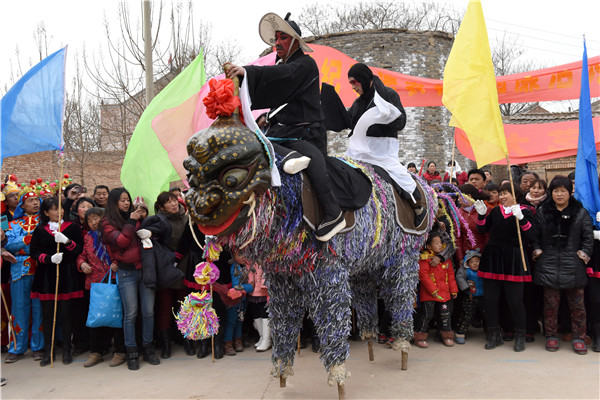
It is unique to Beiyangcheng Village of Jishan County. It is said to have started in the Qing Dynasty. The beast has a unique shape, a huge body, and a complex and labor-costing production. First, the animal body is sewn and bound with hemp silk, hemp paper, fine bamboo, iron wire and cloth, and painted with various colors. Its manufacturing process and method are still a secret to the outside world. There are more than ten kinds of beasts, most of which are strange beasts and monsters, such as unicorns and kylins. Several people play the role of beast. They walk on stilts and bear heavy loads (1-2 riders are on the beast's back). When walking, their steps must be coordinated, which is very difficult. The performance was magnificent, accompanied by majestic gongs and drums, people marching in array.
Fireworks
Commonly known as "setting fire", it is popular in some towns and villages of Yongji, Linyi, Yuncheng, Xinjiang, Ruicheng, Wanrong, Wenxi and other counties (cities). The size of fireworks depends on the number of poles, which are mostly set off in squares or streets. The raw materials are mainly gunpowder and sulfur, the process is complex and labor-intensive. There are two kinds of fire poles, the common one and the old one. Generally, the decoration of common poles is simple, including "square city", "flower tree" and "playing on the swing". The old poles are tall and rich in decoration, including "Eight Immortals crossing the sea", "monk ringing the bell", "golden monkey pounding the rice", etc., which are extremely skillful. The fire rods are connected by powder wires. When the fire is set off, it is from low to high, and finally to the old rod to reach the climax. Anyi Temple of fire in Yuncheng City and Chengguan Temple of Linyi County have a high reputation for fireworks. Each performance will attract tens of thousands of people from neighborhood to watch.
River Lamp
It is popular in villages and towns along the Yellow River in Taiyangdu of Pinglu County, which is said to start in the Tang Dynasty. It is mostly set off on the night of the Lantern Festival every year. The lanterns are exquisitely made and of various shapes. They are made of candles or oil and placed on rafts. On the night of the Lantern Festival, thousands of families competed. The river was full of bright lights. While the lights were surging with the waves and the water was shining, which was spectacular and fascinating.
Story of Blood
It is unique to Baijun Village in Linyi County. Performers will put intestines of pig, sheep and other animals in the waist. Through some special skills, they let the knife and arrow pierce the chest, or cut the back with blade, and painted with blood red. The performance is lifelike and the atmosphere is full of terror. Therefore, it is not beneficial for people to watch the performance, especially for children. After the founding of new China, it has been banned.
